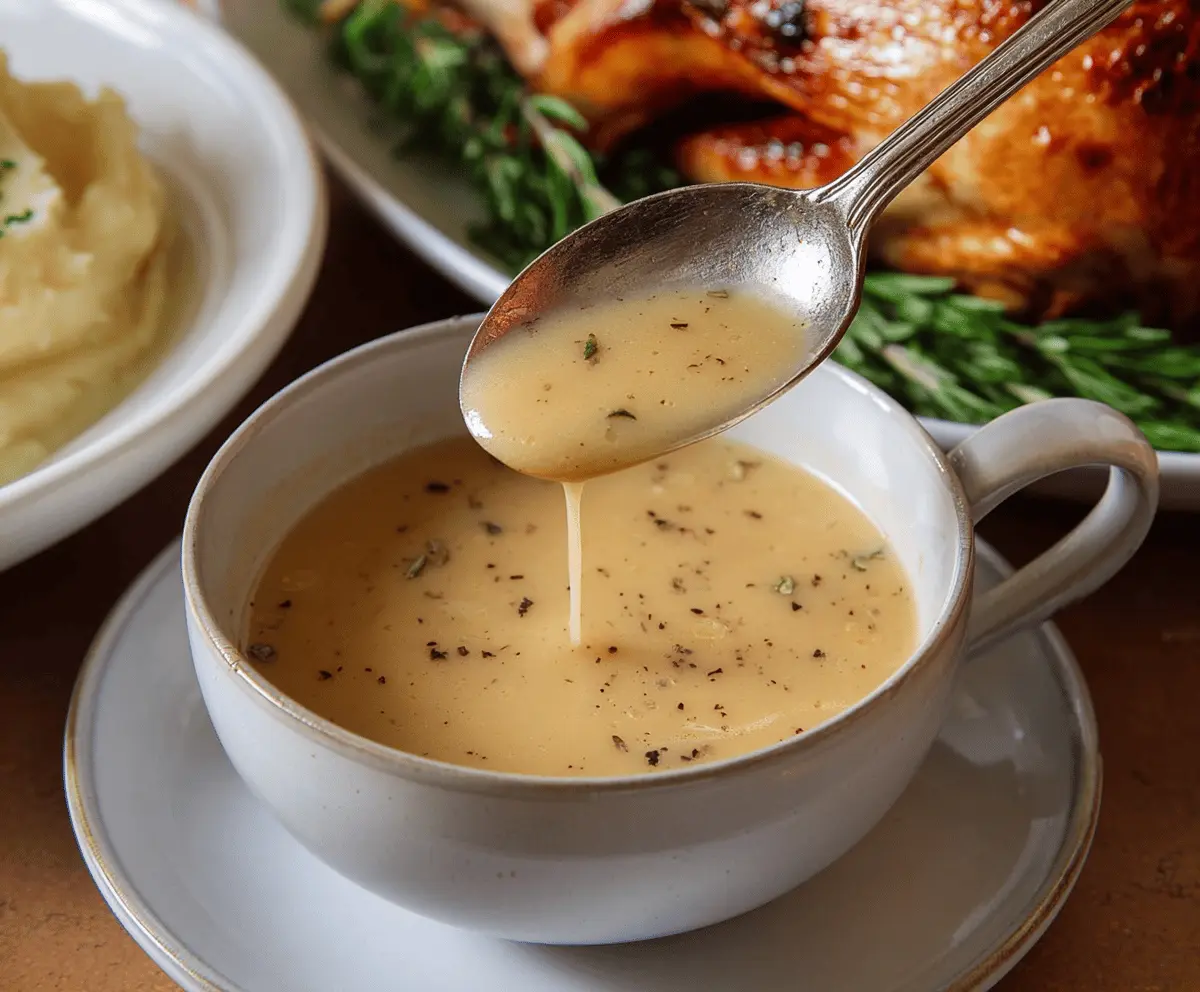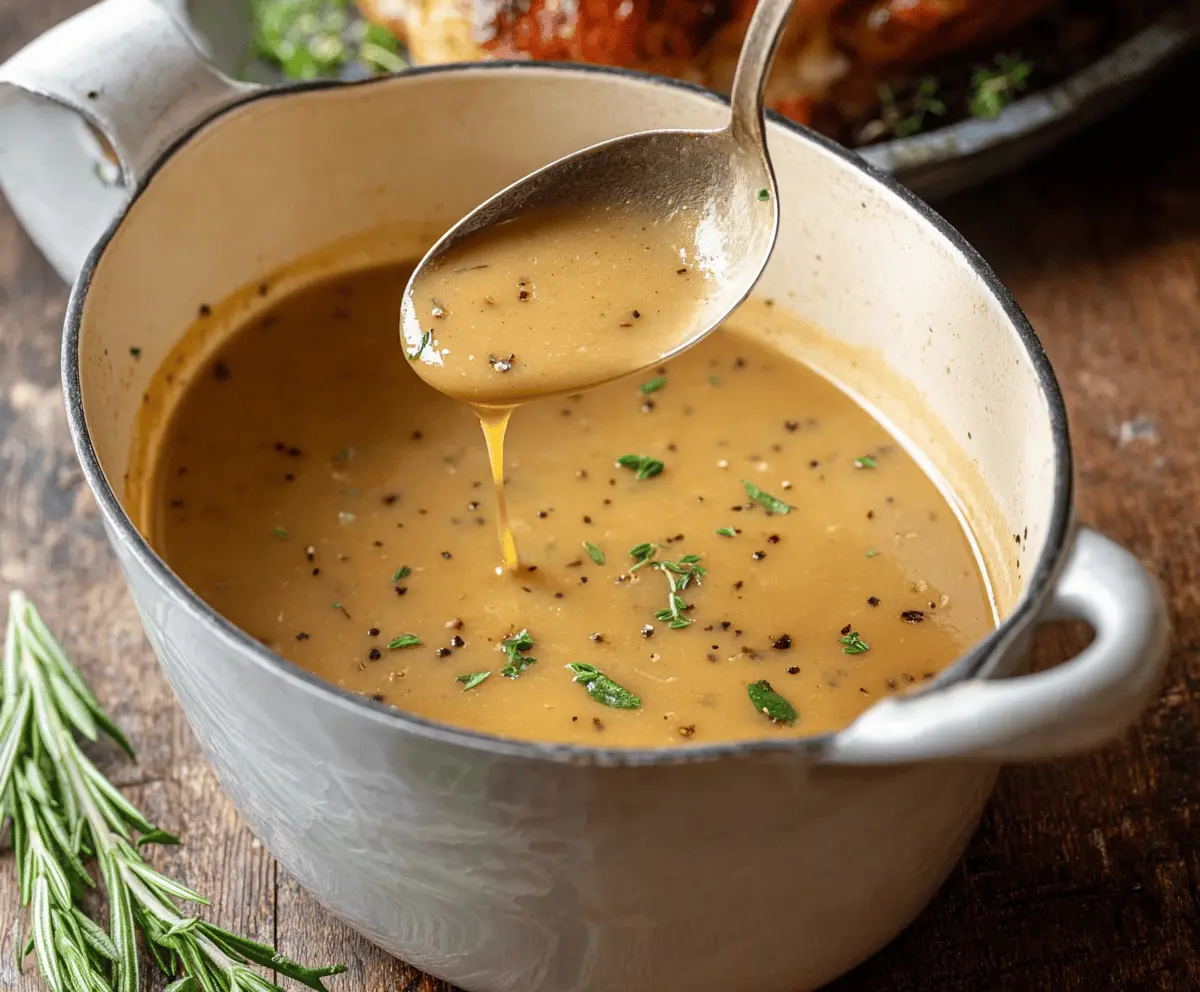Perfect Turkey Gravy is that rich, flavorful sauce that brings the whole holiday meal together. Made from the drippings of a roasted turkey, with a smooth texture and just the right amount of seasoning, it adds warmth and moisture to every bite. Whether you’re pouring it over turkey slices, mashed potatoes, or stuffing, this gravy is an absolute must-have on the table.
I love making this gravy because it feels like the true heart of the feast. Using the pan drippings means it’s full of deep, comforting turkey flavor that you just can’t find in store-bought versions. I always make sure to whisk it well so it’s silky, not lumpy, and seasoned just right to please everyone at the table.
My favorite way to serve this gravy is spooned generously over a warm plate, letting it soak into the turkey and sides. It’s the kind of sauce that brings family and friends a little closer as everyone reaches for seconds. Honestly, a meal isn’t complete without this simple, delicious turkey gravy that feels like a warm hug on a chilly day.
Key Ingredients & Substitutions
Turkey Drippings: These are the heart of turkey gravy, packed with flavor. If you don’t have enough, turkey broth or chicken broth works well. Avoid plain water—it won’t give the same depth.
All-Purpose Flour: Flour helps thicken the gravy. For a gluten-free option, try cornstarch or arrowroot powder; use half the amount and mix it with cold liquid before adding.
Butter and Fat: Butter adds richness, while reserved turkey fat boosts taste. If you’re watching fat intake, you can use all butter or a neutral oil, but flavor may be lighter.
White Wine: This adds a touch of acidity and complexity but is optional. If you prefer no alcohol, just add more broth to keep the right consistency.
Fresh Herbs (Rosemary & Thyme): They bring earthiness that complements turkey well. Fresh is best for brightness, but dried herbs are a handy substitute—use half the quantity of fresh.
How Do I Make Smooth, Lump-Free Turkey Gravy?
Making gravy without lumps can feel tricky. The key is making a good roux and adding liquids slowly while whisking constantly.
- Start by melting butter and reserved fat over medium heat.
- Whisk in flour and cook for 3-4 minutes until golden but not burnt. This cooks out the raw flour taste.
- Add turkey drippings and broth gradually—pour a little in, whisk quickly to combine, then add more. This slow mixing helps avoid lumps.
- Keep whisking as the gravy heats and thickens; patience is key.
- If lumps happen, don’t panic. You can strain the gravy or use a handheld blender to smooth it out.
Using a heavy-bottomed pan helps to cook evenly and prevent burning. Also, remember not to rush the simmer—you want gentle heat so the gravy thickens gradually and flavors come together nicely.

Equipment You’ll Need
- Fine-mesh strainer – I use this to catch any bits and keep the gravy smooth and clear.
- Heavy-bottomed saucepan or Dutch oven – It distributes heat evenly so your gravy doesn’t burn.
- Whisk – Perfect for stirring and preventing lumps when adding liquids.
- Measuring cups and spoons – Keeps everything precise for the best flavor balance.
Flavor Variations & Add-Ins
- Swap white wine for apple cider or omit it altogether for a alcohol-free gravy that’s still flavorful.
- Add a splash of soy sauce or Worcestershire sauce for deeper umami flavor.
- Stir in sautéed mushrooms or caramelized onions for earthy richness.
- Use fresh herbs like sage or parsley instead of rosemary and thyme, to customize the flavor profile.
Perfect Turkey Gravy
Ingredients You’ll Need:
- 4 cups turkey drippings or turkey broth (from roasted turkey pan drippings)
- 1/4 cup all-purpose flour
- 1/4 cup unsalted butter
- 1/2 cup dry white wine or additional turkey broth (optional)
- 1 teaspoon fresh rosemary leaves, chopped (or 1/2 teaspoon dried)
- 1 teaspoon fresh thyme leaves (or 1/2 teaspoon dried)
- Salt and freshly ground black pepper to taste
How Much Time Will You Need?
This gravy takes about 15 to 20 minutes to prepare, including straining the pan drippings and simmering the sauce. It’s best made right after your turkey is done roasting, so you can use the drippings fresh and hot.
Step-by-Step Instructions:
1. Prepare the Drippings:
After roasting your turkey, carefully pour the pan drippings through a fine-mesh strainer into a bowl to separate the fat from the juices. Let it sit for a few minutes so the fat rises to the top. Skim off and reserve about 1/4 cup of the fat for making the gravy.
2. Make the Roux:
In a heavy-bottomed saucepan or Dutch oven, melt the reserved fat with the butter over medium heat. Once bubbly, whisk in the flour. Keep whisking constantly for about 3 to 4 minutes, until the roux turns a lovely golden brown and smells nutty. Be careful not to burn it.
3. Add Liquids and Herbs:
Slowly pour in the turkey drippings and broth in small amounts, whisking continuously to prevent lumps. Next, stir in the white wine if you’re using it, along with the chopped rosemary and thyme.
4. Simmer and Thicken:
Bring the mixture to a gentle simmer, whisking frequently. The gravy will start to thicken after about 5 to 7 minutes. Keep an eye on the consistency, and if it gets too thick, simply add a bit more broth or water to loosen it.
5. Final Touches:
Season your gravy with salt and freshly ground black pepper to taste. For an extra smooth texture, strain the gravy one more time before serving.
6. Serve and Enjoy:
Serve your homemade turkey gravy hot, drizzling it over turkey slices, mashed potatoes, and stuffing. Enjoy the rich, comforting flavors that make every holiday meal complete!
Can I Use Store-Bought Broth Instead of Turkey Drippings?
Yes, you can! While turkey drippings give the richest flavor, store-bought turkey or chicken broth works well too. Just consider adding a bit more seasoning or a splash of soy sauce for extra depth.
How Do I Fix Gravy That’s Too Thick or Too Thin?
If your gravy is too thick, gradually whisk in more broth or water until it reaches the desired consistency. If it’s too thin, simmer it a bit longer to reduce and thicken, or whisk in a little extra flour mixed with cold water (a slurry) and cook until thickened.
Can I Make Turkey Gravy Ahead of Time?
Absolutely! Make the gravy up to two days in advance and store it in an airtight container in the fridge. Reheat gently on the stove, whisking occasionally. You may need to add a splash of broth or water to loosen it back up.
What’s the Best Way to Store Leftover Gravy?
Keep leftover gravy in a sealed container in the refrigerator for up to 3 days. For longer storage, freeze in portions and thaw in the fridge overnight before reheating.
